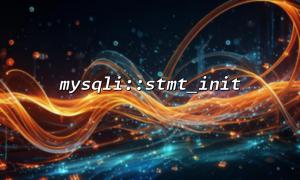When loading GD2 images using PHP's imagecreatefromgd2 function, if the input path is not processed correctly, you may encounter a path traversal attack. An attacker can access sensitive files on the server by constructing specific paths. Therefore, it is very important to correctly prevent path traversal attacks. This article will explain how to effectively prevent such attacks.
A path traversal attack refers to an attacker trying to bypass the security control of the file system by constructing paths containing ../or similar methods and accessing files that should not be exposed. In PHP, if the imagecreatefromgd2 function loads an image without the correct verification path, it may lead to the leakage of sensitive information on the server loading.
The imagecreatefromgd2 function is a function provided by PHP to create image resources from image files in GD2 format. The basic usage method is as follows:
$image = imagecreatefromgd2($filename);
This function takes a file path parameter $filename and returns an image resource. False is usually returned if the path is incorrect or the file is inaccessible.
Attackers can bypass security restrictions by modifying file paths, such as:
$image = imagecreatefromgd2('/var/www/html/uploads/../../etc/passwd');
In the above example, the attacker attempts to access the /etc/passwd file on the server through the ../ part of the path, leaking sensitive information.
In order to prevent path traversal attacks, the paths entered by the user should be strictly verified and filtered. Here are several effective preventive measures:
First, make sure the file path is trustworthy. You can use PHP's realpath() function to convert relative paths to absolute paths and verify that they are in the expected directory. The realpath() function returns the normalized absolute path and parses all symbolic links.
$filename = '/var/www/html/uploads/' . $_GET['filename']; // Get the file path entered by the user
$realpath = realpath($filename);
if ($realpath && strpos($realpath, '/var/www/html/uploads/') === 0) {
// The path is valid,And within the allowed directory
$image = imagecreatefromgd2($realpath);
} else {
// Invalid path,Reject to load
echo "Invalid file path!";
}
In the above code, we first use the realpath() function to get the absolute path of the file, and then check whether it is located in the /var/www/html/uploads/ directory. If not, we refuse to load the file.
File names that are allowed to be uploaded and loaded can be limited to a whitelist. This will prevent any malicious files from being uploaded and loaded.
$allowed_files = ['image1.gd2', 'image2.gd2']; // Whitelist
$filename = $_GET['filename'];
if (in_array($filename, $allowed_files)) {
$image = imagecreatefromgd2('/var/www/html/uploads/' . $filename);
} else {
echo "File not allowed!";
}
Symlinks can be used to perform path traversal attacks. You can ensure that the file path is physically present and does not contain symbolic links by using realpath() . This prevents access to files that should not be accessed through symbolic links.
$filename = '/var/www/html/uploads/' . $_GET['filename'];
$realpath = realpath($filename);
if ($realpath && strpos($realpath, '/var/www/html/uploads/') === 0 && !is_link($realpath)) {
// The path is valid,And no symbolic links
$image = imagecreatefromgd2($realpath);
} else {
echo "Invalid file path or symbolic link detected!";
}
Preventing path traversal attacks is critical when loading GD2 images using PHP's imagecreatefromgd2 function. The risk of such attacks can be effectively reduced by verifying file paths, using whitelists, checking symbolic links, etc. Always be alert to ensure server security and avoid sensitive data breaches or server attacks due to path traversal vulnerabilities.















